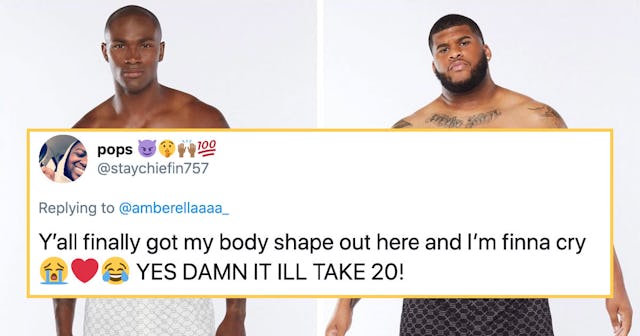This Viral Tweet Reminds Us That Body Positivity/Inclusivity Is Important For Men Too

As a teenage girl in the ‘80s and ‘90s, it was rare I saw someone with my body type. I was taller and had bigger hips and boobs than all my friends did. My hips and thighs are adorned with stretch marks and I started buying control top pantyhose when I was twelve to try and slim myself down.
It was a time when models in magazines were rail thin, and the straighter you were, the more attractive you were thought to be. Not much has changed, as far as I can tell.
I remember one afternoon flipping through Vogue with my bestie as we rubbed all the perfumed pages on our wrists and we came across a model standing in a desert somewhere. “Her thighs and calves are the same size all the way down,” my friend said wistfully. “She’s perfect.”
I looked down at my legs and saw my fleshy inner thighs and the way my legs got bigger from the ankles up — something that I’d never really noticed until that afternoon. That was the day I started loathing my legs.
I thought this was exclusive to women, one of the unfortunate side effects of the diet culture that permeates everything we read and watch. It wasn’t until I became a mother and had two boys of my own that I realized when a boy or a man sees something in an ad, a magazine, or online, they compare themselves too.
When my youngest son was twelve, he hated the fact he was so skinny and he started lifting weights.
Then he started counting calories and protein grams, and wouldn’t eat any sugar.
For a while, he wanted to be lean but really muscular and was obsessed with watching workout videos and learning about techniques to grow muscles faster.
He began surrounding himself with images that were telling him he wasn’t good enough the way he was and he needed to look a certain way to feel worthy because he didn’t notice his long, very slim, body type being represented anywhere.
Well, except for the “wimpy kid’ that got picked on in movies.
It passed, but I had to have several talks with him, and he went into therapy. Through this help, he was able to realize when he didn’t look at really built men without any body fat all the time, he began to feel better about himself. He didn’t feel so pressured to limit his food intake and over-exercise.
My oldest son is built the same and always covers up his six-foot one, 135-pound body with baggy sweat suits — even on a hot day. He refuses to swim shirtless and it’s rare he’ll get into his swimming trunks. All because he feels self conscious about the way his body looks.
My point is, a negative body image that’s fueled by what we see on social media or television doesn’t just affect females. Yes, it’s always been a huge struggle for girls and women. There’s airbrushing, filters, and not all body types are being represented. We’ve been conditioned to believe being beautiful means you have to fit in a very specific (and very small) container.
Girls and women may have it worse, but boys and men are by no means immune to body dysmorphia, eating disorders, or feeling like their body types aren’t being represented. In fact, NEDA reports that about one third of people struggling with eating disorders are male.
And this Twitter thread posted by @amberellaaa_ showing a male model for Rihanna’s lingerie brand, Savage X Fenty, is proof that men feel the effects of the pressure society puts on them to look a certain way, even if we think it doesn’t exist.
This picture obviously hit different to a lot of people, and the comments are proof that we all need to see different body types represented on all platforms. We need to stop with the photoshopping, airbrushing, and let people see their body types represented all over the damn place, not just every once in a while.
One reader wrote about how emotional it made him feel to actually see someone in an ad that looked like him.
This is the only way we are going to normalize all different bodies and stop with the notion that only people who are slim, or muscular, or have big boobs and a tiny waist are the only attractive and worthy physiques. And yes, stretch marks are normal, people! Cellulite too.
As parents to boys, we have to open our eyes to the fact they are seeing these images of other men and ingesting the idea that there’s a certain standard they should adhere to.
They may not talk about it as much as our daughters or our female friends do, and we may not see them doing things to alter their appearance, but that doesn’t mean they aren’t thinking about it.
Seeing different body types that aren’t altered can do so much for their self esteem and reassure them they are completely normal and they don’t need to look a certain way to be worthy.
Most women can relate to being young and impressionable and seeing these images of airbrushed perfection that seem completely unattainable, yet are somehow also held up as the ideal. Think of how low it can make you feel, of the self-criticism that those images inspire, of the lifelong self-consciousness and disordered eating patterns that can spring from it.
Our boys are no different. Hopefully seeing all body types represented equally — male and female alike — will soon become the rule, not the exception.
This article was originally published on